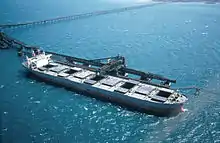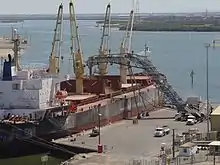Shiploader
A shiploader is a large machine used for continuously loading bulk solid materials such as iron ore, coal, fertilizers, grains and/or material in bags onto ships or barges. These machines are located in ports and jetties to facilitate bulk material exportation. Generally shiploaders are engineered to suit specific project requirements. Those requirements often include: port design, material characteristics, loading capacity, vessel type, local law, and budgetary limitations. A shiploader mainly consists of a central column, an extendable arm or boom, a belt conveyor extending out of the boom structure, a slewing mechanism, and a loading chute to transfer product from a source conveyor or feeder. The boom can move front and back, up and down by separate drives so that it can fill the whole breadth of the ship hold and adapt to the ships increasing draught while it is loaded.[1]

The shiploader is essential to the global shipping industry. Globalization has promoted the need for international maritime ports to be equipped with efficient and durable shiploading machinery able to a handle the great variety of materials that enter into harbors within short time frames. This need for efficiency of loading and unloading has promoted advances in shiploader technologies. There are two main types of shiploaders, stationary and mobile. The distinguishing element between the two is portability versus immovability.[2]
Stationary shiploaders
Most shiploaders are stationary installations. Relative simplicity of structure combined with initial lower acquisition and maintenance costs are the greatest advantages of the stationary shiploaders. Stationary shiploaders operate within the confines of the wharf length; no costly redesign of wharf length is required. This setup comes at a cost however; the greatest disadvantages lie in its operating costs and operating efficiency. Being a fixed apparatus, the stationary shiploader requires that the vessel itself be moved then secured relative to the shiploader to allow filling of each of the different cargo holds. This process exposes the ship and the docking structure to the hazard of accidental collisions. The movement of the ship for each of the holds is both time and manpower consuming, which results in a costly low average loading rate.[3]
Mobile shiploaders

There are two standard types of mobile shiploaders available: the partially mobile, rail-travelling shiploader and the fully mobile, wheel mounted shiploader. Both types of mobile shiploaders benefit from portability of design. This design creates a loading process much less complicated than the stationary shiploader because both rail-travelling and wheel mounted mobile shiploaders reach all ship holds for loading without the movement of the vessel. This process also significantly reduces operating costs in the form of both time expended and manpower required.[4] The disadvantage of the mobile shiploaders is found in its space requirements. Mobile shiploaders generally require either a substantial existing wharf site length or the necessity of a wharf length extension.[5]
The quantifying difference between the two mobile shiploaders is that the rail-travelling shiploader is relegated to linear rail lines installed along the length of the wharf, whereas the wheel mounted mobile shiploader allows for free movement. Rail-traveling loaders require the added expense of the purchase and installation of dock railings.[6] Wheel mounted mobile shiploaders offer access to the vessel not limited by rail tracks. This increased mobility increases accessibility and flexibility. In addition, integrated tow hitches enable the storage of the unit away from the quayside when not in use.[7]
Innovations in shiploading
In response to the challenges of standard shiploading choices, innovations in the industry have been created. A few companies (Superior, Telestack, TAKRAF) have designed mobile radial telescopic shiploaders. These machines utilize the mobility of the wheel mounted mobile shiploader combined with extendable and retractable radial boom lengths to access the cargo holds. This mechanical combination promotes the reduction of movements necessary for vessel loads, thereby increasing productivity.[8]
One of the most unique innovations to overcome the challenges in the shiploading industry has been the design of the wheel mounted, DSI Snake Shiploader. Standard mobile shiploaders require substantial wharf space in which to maneuver. Dockside real estate is expensive and limited; the DSI Snake Shiploader utilizes a high angle material lifting technology which radically reduces wharf space required. This technology utilizes high angles combined with the Sandwich belt conveying design to hold and hug the loading material between two belts to load the ship cargo. This use of height instead of length greatly reduces the loading footprint on an already limited sized wharf.[9]
This system also promotes industry efficiency via transfer point spillage elimination:
“Because conventional ship loaders involve movement of large volumes of cargo via a series of belt conveyor systems from the quayside to the discharge boom, there is a likelihood of material spillage occurring at the different belt transfer points. This problem has been avoided by Dos Santos International which, working in association with Cortex Resources, recently delivered a ship loader to Port Adelaide, Australia, which incorporates a Snake Sandwich high angle conveyor belt system which does not require transfer points. It has therefore eliminated spillage problems during ship loading of titanium ore.“[10]
References
- Ph.D, Michael Rivkin (2018-09-15). Bulk Material Handling: Practical Guidance for Mechanical Engineers. Partridge Publishing Singapore. pp. 259–262. ISBN 9781543746426.
- "Global Ship Loader & Unloader Market expected to reach approx. USD 65,850 Million by 2025 | Bulk-Blog". Retrieved 2019-10-18.
- Horak, Ralph M (1997). "EP0980328A4 European Patent Office". Google Patents.
- Ph.D, Michael Rivkin (2018-09-15). Bulk Material Handling: Practical Guidance for Mechanical Engineers. Partridge Publishing Singapore. pp. 267–268. ISBN 9781543746426.
- "Cargo Handling: Little loaders fill the market". Bulk Materials International: 12. Dec 2012 – via http://elbengineering.co.za/wp-content/uploads/2016/08/ES_Media_Bulk-Materials-International-Nov-Dec-2012.pdf.
- "Choosing the right ship loader for handling bulk materials: which one is right for your facility?Choosing the right ship loader for handling bulk materials: which one is right for your facility?". Port Technology International. Retrieved 2019-10-18.
- Dodds-Ely, Louise (June 2018). "Lightening the load: shiploading technologies continue to evolve" (PDF). Dry Cargo International. 214: 92.
- "Superior New mobile ship loader". CEMAnet. May 2013. Archived (PDF) from the original on Oct 2019.
- "Recognized potential promise fulfilled". www.drycargomag.com. Retrieved 2019-10-18.
- "GreenPort | Bulk cargo handling cleans up its act". www.greenport.com. Retrieved 2019-10-18.
External links
| Wikimedia Commons has media related to Ship loaders and unloaders. |
